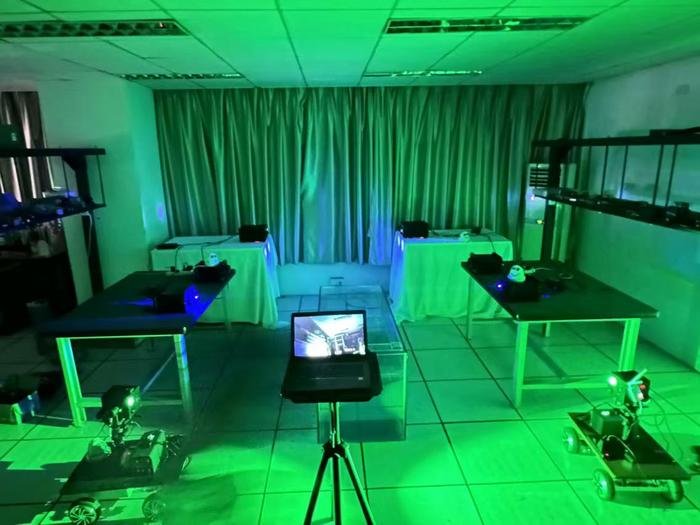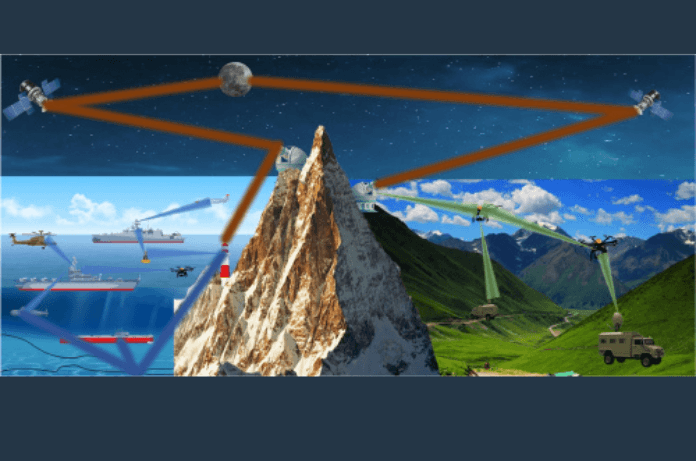Imagine a world where drones, ships, and other air or underwater vehicles can seamlessly exchange data in real-time, whether flying through the air, navigating on land, or cruising underwater. That world is now closer to reality, thanks to a groundbreaking prototype mobile all-light communication network developed by researchers. This innovative system enables uninterrupted data exchange across different environments, even when the communication nodes are in motion. The possibilities for applications such as navigation, emergency response, scientific research, and commercial operations are endless.
Bridging Connectivity Across Air, Land, and Sea
Traditional communication networks often struggle with maintaining connections across dynamic and challenging environments. In scenarios where vehicles, drones, or submarines are constantly moving, maintaining a stable data link becomes a formidable challenge. Enter Yongwin Wang and his research team from Nanjing University of Posts and Telecommunications in China, who have tackled this issue head-on.
“Our all-light wireless network combines different light sources to ensure uninterrupted connectivity while also dynamically aligning optical paths between moving nodes,” Wang explained. This allows for two-way, real-time data transmission, guaranteeing seamless communication and data exchange regardless of the setting.
In their paper published in the Optica Publishing Group journal Optics Express, the team demonstrated how their prototype can achieve bidirectional light transmission between nodes deployed on two moving vehicles, even when transitioning between air and underwater environments.
A New Era of Mobile Networks
This all-light communication system has the potential to revolutionize mobile networks as we know them. “Our new wireless optical communication system could enable continuous connectivity for essential mobile nodes like drones, vehicles, and ships,” Wang noted. The system not only improves connectivity but also opens new avenues for how mobile networks can function.

The Alignment Challenge: Solved
Previous experiments with all-light communication relied on fixed communication nodes. However, the real challenge was enabling these nodes to communicate while in motion. The key breakthrough in this research is the ability to dynamically align optical paths between moving nodes. Wang and his team achieved this by creating an image identification module and a full-duplex light communication module mounted on a three-axis gimbal stabilizer.
Here’s how it works:
- The image identification module captures real-time images of incoming light signals.
- It provides feedback to the three-axis gimbal stabilizer, adjusting the optical alignment dynamically.
- This setup ensures that the communication path remains aligned, enabling bidirectional data exchange even under the Transmission Control Protocol/Internet Protocol (TCP/IP) scheme.
The Technology Behind the Network
The system combines multiple light communication technologies:
- Greenlight communication for TCP/IP-based data transfer.
- Blue laser communication for underwater data exchange.
- Deep ultraviolet (DUV) communication for “solar-blind” data transfer, which avoids interference from sunlight.
- An 850-nm laser diode system for receiving data.
These components are connected through Ethernet switches that link to various devices such as sensors and personal computers.
Real-World Demonstration: Air and Water Connectivity
To test the system, the researchers mounted two green-light communication devices with image identification modules on separate moving vehicles. These tests were conducted:
- On an outdoor lawn at night.
- In full sunlight conditions.
- In an indoor water tank simulating underwater environments.
The results were impressive. The system successfully achieved bidirectional light transmission between moving nodes across air and water. It demonstrated a maximum modulation bandwidth of 4 Mbps, sufficient for transmitting video and audio data seamlessly. Additionally, the network provided internet access via a Wi-Fi modem.
Performance and Efficiency Insights
The prototype’s efficiency was equally remarkable. During communication, the entire system, including network switches and Wi-Fi modules, consumed an average power of 122 W. Of this, the light communication links accounted for 78.6% of the power usage.
Despite these successes, there remains a bottleneck in the BLC and WLC links due to the limitations of current LED modulation. Future improvements, such as using advanced modulation techniques or wavelength-division multiplexing (WDM) with red, green, and blue LEDs, could significantly enhance throughput.
Future of All-Light Networks
Looking ahead, the researchers envision a more advanced all-light communication network that integrates both wired and wireless nodes. Combining light communication with radio, sonar, and gas-based communication technologies could establish a robust, future-proof communication network.
“In the future, we could combine on-chip light communication with free-space light communication to create an all-light interconnection communication network,” Wang added. Such networks could seamlessly transmit data across various environments and devices, opening possibilities for advanced information processing and computing systems.
The Path Forward: Endless Possibilities
The potential applications of this all-light network are vast:
- Drones conducting search and rescue missions.
- Autonomous vehicles maintain constant connectivity.
- Underwater exploration by submarines exchanging data in real-time.
- Commercial operations require uninterrupted communication across land and sea.
This innovative prototype could redefine how we think about connectivity. In the 6 G era, an integrated network with global connectivity, covering communication across ground, space, and underwater communications, will be built.
The development of this prototype mobile all-light communication network is a game-changer. By solving the challenges of dynamic optical path alignment and integrating diverse light communication technologies, researchers have laid the groundwork for a future where connectivity knows no bounds.

